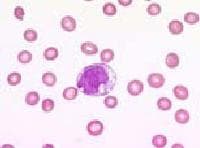Myelodysplastic syndrome (MDS) refers to a heterogeneous group of closely related clonal hematopoietic disorders. All are characterized by a hypercellular or hypocellular marrow with impaired morphology and maturation (dysmyelopoiesis) and peripheral blood cytopenias, resulting from ineffective blood cell production.
All 3 cell lineages in myeloid hematopoiesis can be involved, including erythrocytic, granulocytic, and megakaryocytic cell lines. Although clonal, MDS is considered a premalignant condition in a subgroup of patients that often progresses to acute myelogenous leukemia (AML) when additional genetic abnormalities are acquired.
See the following image depicting MDS.
Blood film (1000× magnification) demonstrating a vacuolated blast in a refractory anemia with excess of blasts in transformation. Courtesy of U. Woermann, MD, Division of Instructional Media, Institute for Medical Education, University of Bern, Switzerland.
Patients with MDS may present with clinical manifestations of anemia, thrombocytopenia, and/or neutropenia (see Clinical). The workup in patients with possible MDS includes a complete blood count with differential, peripheral blood smear, and bone marrow studies (see Workup).
Standard care for MDS is constantly changing, but it typically includes supportive therapy, including transfusions, and may include bone marrow stimulation and cytotoxic chemotherapy. Bone marrow transplantation has a limited role. (See Treatment.)



No comments:
Post a Comment